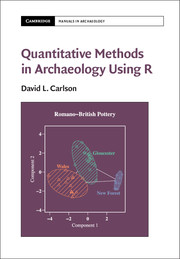Book contents
- Frontmatter
- Contents
- List of Figures
- List of Tables
- List of Boxes
- Acknowledgments
- 1 Introduction
- PART I R AND BASIC STATISTICS
- 2 Introduction to R
- 3 Looking at Data – Numerical Summaries
- 4 Looking at Data – Tables
- 5 Looking at Data – Graphs
- 6 Transformations
- 7 Missing Values
- 8 Confidence Intervals and Hypothesis Testing
- 9 Relating Variables
- PART II MULTIVARIATE METHODS
- PART III ARCHAEOLOGICAL APPROACHES TO DATA
- References
- Index
6 - Transformations
from PART I - R AND BASIC STATISTICS
Published online by Cambridge University Press: 22 July 2017
- Frontmatter
- Contents
- List of Figures
- List of Tables
- List of Boxes
- Acknowledgments
- 1 Introduction
- PART I R AND BASIC STATISTICS
- 2 Introduction to R
- 3 Looking at Data – Numerical Summaries
- 4 Looking at Data – Tables
- 5 Looking at Data – Graphs
- 6 Transformations
- 7 Missing Values
- 8 Confidence Intervals and Hypothesis Testing
- 9 Relating Variables
- PART II MULTIVARIATE METHODS
- PART III ARCHAEOLOGICAL APPROACHES TO DATA
- References
- Index
Summary
Raw data comes in many sizes and shapes and occasionally they are the wrong sizes and shapes for what we want to do with them. In those situations, it can be useful to transform them before analysis. Transforming data is often useful to balance a non-symmetric distribution or to pull in outlying observations to reduce their influence in the analysis. Transformations can be applied down columns (e.g., standard scores to weight each variable equally) or across rows (e.g., percentages to weight each assemblage equally). In general, there are four data problems that can sometimes be resolved with transformations.
First, transformations can help to produce a distribution that is closer to a normal distribution, making it possible to use parametric statistical methods (such as t-tests). In this case, we are looking at the raw data distribution and using an order-preserving transformation that makes the data more symmetrical. The alternative to transforming the data is to use nonparametric tests that do not require a normal distribution or robust statistical methods that are not as influenced by extremely large or small values.
Second, transformations can make it possible to use simple linear regression to fit nonlinear relationships between two variables. Transforming one or both variables makes the relationship between them linear. The drawback with this approach is that the errors are transformed as well so that additive errors become multiplicative errors when using a log transform. The alternative to transformation is to use nonlinear regression.
Third, transformations can be used to weight variables equally so that differences in measurement scales or variance do not give some variables more influence than others in the analysis. This is particularly important when we are using the concept of “distance” between observations (Chapter 14).
Fourth, transformations can be used to control for size differences between assemblages or specimens that we want to exclude from the analysis in order to focus on shape or relationships between variables that are independent of differences in size. In this case the transformation is applied to the rows of the data. First, we will consider a collection of R functions that are useful for a number of purposes, including transformation.
Information
- Type
- Chapter
- Information
- Quantitative Methods in Archaeology Using R , pp. 126 - 143Publisher: Cambridge University PressPrint publication year: 2017
